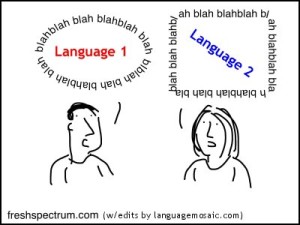Contemplating a Curriculum for Human Languages Literacy, Part 3: Languages have specific differences which can be compared and contrasted
This blog entry is the third (3rd) in a multi-part series describing what a curriculum for human languages literacy might look like.
 Our topic for today is a corollary of sorts to the previous topic. If languages can be analyzed and studied, then they can be compared and contrasted with each other. The big take away here is that languages are not independent systems that each have their own science. Each language is different from another to be sure. But they all have mechanisms and ways of organizing that are related in some way. We might say the building blocks are similar.
Our topic for today is a corollary of sorts to the previous topic. If languages can be analyzed and studied, then they can be compared and contrasted with each other. The big take away here is that languages are not independent systems that each have their own science. Each language is different from another to be sure. But they all have mechanisms and ways of organizing that are related in some way. We might say the building blocks are similar.
I will take just three examples from yesterday’s list of language subtopics to illustrate:
- Syntax:
- Languages have different word orders, or grammar. Some languages, like English, usually put the subject of the sentence first, followed by a verb. Then, if there is an object, it comes last. So the prototypical word order is Subject-Verb-Object or SVO for short. An example sentence would be:
He opened the door. S V O
- On the other hand, some languages normally have a subject-object-verb (SOV) order. So, for example, in Turkish, “O kapıyı açtı.” Is literally “He/She – the door – opened.
O kapıyı açtı. he/she - the door - opened S O V
- Yet still other languages are VSO languages. Maybe 15% of all languages have VSO order, with SVO and SOV at approximately 40% each. Other word orders exist as well. But the number of those languages is very small.
- Phonetics:
Languages have different sounds and different “kinds” of sounds. Some languages will have more vowels, some fewer. For example, English doesn’t have the vowel represented by the umlauted u (ü) used in German. Some languages will have a clear distinction between two consonants while another doesn’t distinguish them. Spanish “b” and “v” are generally considered indistinguishable in Spanish. And some types of variation will be meaningful in one language but not in another. In English, for example, a change of pitch is used to emphasize one thing or another without changing the meaning of individual words. But in Chinese, the same type of sound with a different pitch will have a different meaning. Here’s a recent article explaining how pitches work in tonal languages like Chinese: The World’s Most Musical Languages
- Sociolinguistics:
Languages use different forms of politeness. In English, we have just one pronoun for a male, “he.” But in some languages, a different word is used for males that are children and males that are older. In some languages, it is inappropriate for a child to address an adult with and informal “you.” The child should use a more polite form.
These are just some of the ways we can compare and contrast languages. Simply recognizing and being alert to these ranges of possibilities is helpful for learners as they get their heads around a new language. And although these varying forms may seem illogical or inefficient to our minds at first, they are absolutely, positively rational and effective for native speakers. So, to really dive into a new second language you’ve never spoken before, you will need to think in ways you never have before.
Coming next: Languages change over time – sometimes systematically, sometimes arbitrarily
Contrastingly yours,
Mike
(Mike’s bio)
P.S. As always, critiques or affirmations are very welcome! You may comment publicly below or contact me privately on the contact page.

Leave a Reply